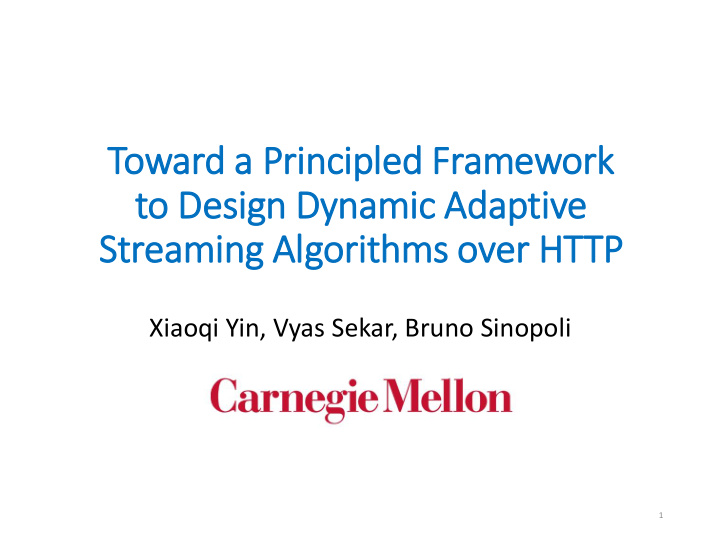



Toward a Principled Framework to Design Dynamic Adaptive Streaming Alg lgorithms over HTTP Xiaoqi Yin, Vyas Sekar, Bruno Sinopoli 1
Design Dynamic Adaptive Streaming (D (DASH) algorithms is is cri ritical for better QoE B/W Video Bitrate Source Time Adaptive Internet Video Players 2
Vid ideo pla layer model B/W Video Player Predictor Predicted B/W GET Bitrate Bitrate HTTP Internet Controller Chunk Buffer occupancy Buffer QoE End User 3
Vid ideo pla layer adaptation is is hard • Hard to predict bandwidth • It is a stochastic variable difficult to estimate • Interaction with TCP • Makes bandwidth estimation even harder • Various factors can impact QoE • Often in conflict, e.g., high quality vs. few stalls • Discrete feedback and control • Discrete bitrate levels, change bitrate only in discrete time 4
Ple lenty of f algorithms, , lit little cla larity • 50+ papers in the past 5 years Buffer-based Rate-based Estimated B/W B/W Controller Bitrate k Controller Bitrate k Buffer Buffer “Control buffer to certain level” “Match bitrate with bandwidth” 5
We need a systematic fr framework! Several point solutions! Objective they (should) optimize? Rate Buffer-based i.e., Buffering vs. switching vs. bitrate based Bitrate k Sensitivity to operating regimes A1 A3 ? e.g., When is A1 better than A2? A2 Are they optimal? Buffer Broader design space is possible Design space B/W of all algorithms 6
Stochastic optimal control fr framework Choose optimal bitrate for all chunks in a video R 1 , R 2 , … , R K Formally Defined To maximize QoE: q(avg bitrate, bitrate switches, rebuffer time) Sensitivity Subject to: To Operating • Parameters Buffer occupancy dynamics: Buf k+1 = g( Buf k , B/W, R k ) Broader • Available bandwidth Design Space Online controller design: R k = f (Buf k , Predicted B/W) 7 Known precisely Predicted with error
Algorithm via Model Predictive Control (M (MPC) Choose optimal bitrate for all chunks in a video R 1 , R 2 , … , R K To maximize QoE: q(avg bitrate, bitrate switches, rebuffer time) Subject to: • Buffer occupancy dynamics: Buf k+1 = g( Buf k , B/W, R k ) • Available bandwidth Online controller design: R k = f (Buf k , Predicted B/W) 8 Known precisely Predicted with error
Model predictive control • Use both bandwidth and buffer 1. Moving 2. Predict : information horizon : At step k, Predict B/W plan for next N within the chunks (k to k+N) horizon k to k+N • Smoothing out prediction error at each step 3. Control : Select • Embed the control bitrates to maximize objective directly QoE within the horizon, apply 1 st bitrate R k into controller 9
Main result: MPC > BB > RB 10
Does prediction error matter? MPC > BB BB > MPC 11
Summary of f oth ther in insights • All algorithms benefit from finer-grained bitrate sets • MPC/BB can achieve near-zero buffering while RB cannot • MPC do better on avoiding bitrate variations 12
Dis iscussion & Li Limitations • Full-spectrum sensitivity analysis • Bandwidth estimation, interaction with TCP • Characterizing bandwidth stability/predictability • Multi-player interactions • Computational complexity 13
Conclusions • Lots of confusion in video player design • What is the objective? How to compare algorithms? • How sensitive is the solution? • Use control theory to bring rigor to DASH design • MPC outperforms BB and RB in certain conditions • Future work: Bring control-theoretic framework to practice Thank you! 14
Recommend
More recommend